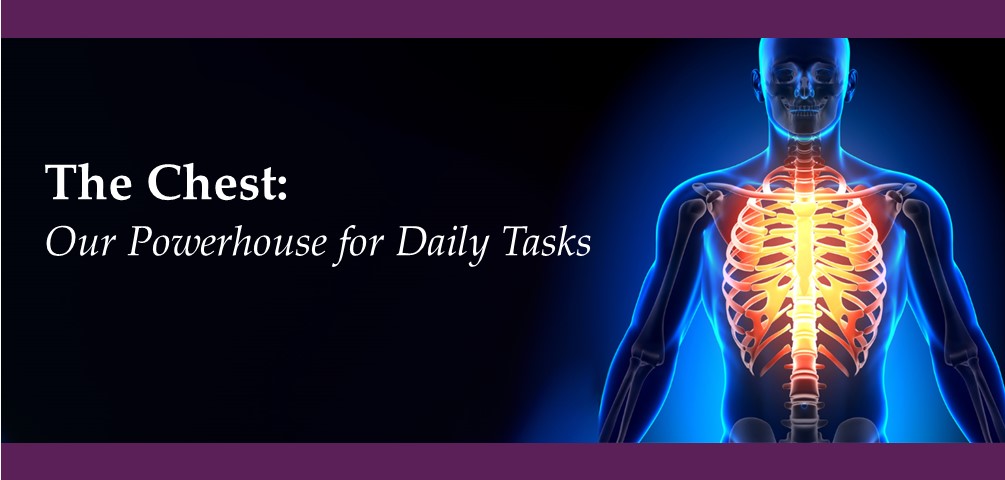
Live Comfortably - April 24, 2023
By Leslie LaPlace
It’s been a while since the last article in our anatomy series, but let’s continue our exploration of the bones and muscles that make up key areas of our bodies. As we work our way up the body, we’ve arrived at the chest. This part of the body encompasses the heart and lungs and allows you to use your arms. It’s key to many of the body’s functions and functional movements.
Now that we know why the chest and its strength are so important, let’s look at its skeletal structure.
The main structure of the chest, the thoracic cage (aka rib cage), is made up of the rib bones, thoracic vertebrae and the sternum. Their primary function is to protect your vital organs. They must be strong enough to withstand immense impact during traumatic events, yet flexible enough to allow for the ribcage to compress and expand along with the lungs as you breathe. The different types of cartilage and bone in the thoracic cage allow for flexibility, strength and protection. The arms attach to the rib cage structure, securing them to the trunk of the body.
There are 12 pairs of ribs that are anchored to the thoracic vertebrae in the spine (T1-T12). In front, the ribs are attached to the sternum (or breastbone) by costal cartilages. The first seven ribs are called “true ribs” as they attach to the sternum directly with their cartilages. Of the remaining five ribs, which are called “false ribs”, the first three have their cartilages connected to the cartilage above them. The last two, the floating ribs, have their cartilages ending in the muscle in the abdominal wall.
The sternum is a long, T-shaped flat bone located directly at the center of the chest. At the top, it connects to the clavicle (collarbone). You can easily feel the sternum with your hands.
Now that we’ve explored the bones of the chest, let’s move on to the muscles.
The pectoral muscles attach the shoulders and arms to the clavicle and the thoracic cage. These muscles include the pectoralis major, pectoralis minor, subclavius and the serratus anterior muscle.
The dominant muscle in the upper chest is the pectoralis major or pec major. This large, fan-shaped muscle stretches from the armpit up to the collarbone and down across the lower chest region on both sides of the chest. The two sides connect at the sternum. The pectoralis major moves each shoulder joint in four distinct directions, and it keeps the arms attached to the body.
The pectoralis minor is a small, triangular muscle that lies beneath the pec major and controls structures associated with the back of your body. This muscle attaches to the ribs and the shoulder blade allowing it to help depress (pull down) and spread apart the shoulder blades and assist with breathing.
The serratus anterior is commonly grouped with the chest muscles because it attaches to the ribs near the pectorals. Its functions are to move the scapula (shoulder blades) forward and upward. It is sometimes called the “boxer’s muscle” because it enables a person to throw a punch.
Your chest holds many of the structures needed for living, including your esophagus, your windpipe, your lungs and your heart. The chest muscles are responsible for moving the arms across the body and up and down, in addition to moving the arms. They also enable you to use your arms to push.
You use chest muscles all day long―when pushing open a door, washing your hair or simply maintaining good posture. It’s important to keep these muscles strong for many daily activities such as lifting, holding, pushing and even breathing.
While I am a firm believer in the importance of upper body strength, be sure to balance any chest exercises with some back exercises. You should also take the time to stretch after workouts.
We often spend so much time sitting―at the computer, reading, sewing, etc.―that our shoulders start to round and the chest muscles get tight. Take breaks when sitting for long periods of time and stretch the muscles in your chest, lower back and front of the legs to counteract tightness.
In this 30-minute video, I’ll walk you through chest exercises and stretches that you can do to build upper body strength and flexibility. Review it as many times as you need – whether that’s following this workout several times a week or checking back every few months to ensure you’re performing the exercise properly. Stay consistent with these exercises and notice how your daily movements become easier!
______________________
Leslie LaPlace, Fitness Manager at Goodwin House Alexandria, is a self described recovering Software Development Project Manager. Leslie parlayed a lifelong love of and belief in the restorative power of exercise into a satisfying career working with adults ages 55 and older. She believes that staying active can help reduce aches and pains—It’s also a great anti-aging remedy. She has more than eight years’ experience working with seniors at Arlington County, The Jefferson, Goodwin House Bailey’s Crossroads and Goodwin House Alexandria. Leslie is a certified personal trainer and aquatic instructor who loves creating a positive and fun training experience. She believes that it’s never too late to improve your strength and balance!
